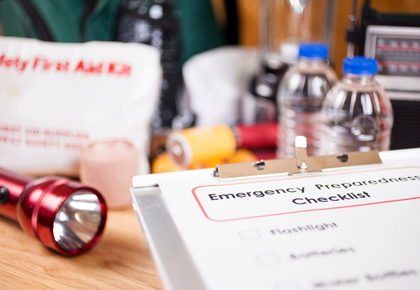Severe Weather: What to Do and How to Stay Safe
It’s no secret that Alberta is seeing it’s fair share of severe weather and on a more regular basis. Ruthless thunderstorms, high winds, and hail are something everyone should be prepared for. Hail can be a common side effect from a severe storm, and something Alberta is familiar with.
In fact, a June 2020 hailstorm in Calgary shredded vinyl siding on homes, shattered vehicle windshields and flooded major roadways. The storm cost a whopping $1.2 billion and is the fourth costliest natural disaster in Canadian history.

For Calgary this is no surprise as it’s considered the epicentre of hailstorms in Canada. On average it sees five hailstorms per year. While hailstorms are more seasonal taking place from May through September with mid-June and early August being the peak time, something Albertans have come to expect at all times of the year is high winds.
“Of course, you can’t prevent severe weather, but you can make sure your community is as prepared and ready as possible," says Glenne Manlig, president of FirstService Residential Alberta. Dangerous storms and high winds arise with little or no warning but there are things you can do to minimize potential injury and damage in your community. Getting through it safely is the goal.
If you’re a member of your condominium corporation’s board, you’ll want to take additional measures to protect your residents and property. One of the most important things you can do is make sure your residents are informed about the risks of dangerous storms and how to respond.
Ways to keep emergency preparedness top of mind for your residents include providing emergency response information on a regular basis, perhaps within a quarterly newsletter. For more in-depth information, you can prepare a handbook that is updated on an annual basis and provided to residents and/or kept in easy to find places.
When harsh weather is on its way, we also recommend sending out a notice to remind residents to remove anything from their balconies. Storm winds can be strong enough to pick up items, throw BBQ propane tanks around, and pose real threats to residents. Not to mention the collateral damage they can cause in their wake.
If your community is partnered with a quality property management company, you can rely on them to assist with immediate communications to residents during an emergency using a system that can send texts, emails, and phone calls. Let’s take a look at some of the things you, as a board member, should be communicating to residents about what they should do to prepare for severe weather.
1. Understand the Basic Terminology of Severe Weather
It’s important to understand standard weather terms used by the Canadian government and the media to describe their severity and probability of different types of storms. Special weather statements are typically issued for severe thunderstorms, hail and extreme heat. A tornado watch means that conditions favour the formation of tornadoes, so stay tuned to emergency broadcasts and be ready to take shelter. A tornado warning is issued when a funnel cloud is sighted or indicated by radar – if so, take shelter immediately. Wind warnings are issued when winds are expected to reach at least 70 km/h, or gust at least 90 km/h.
To make sure you are aware of watches and warnings, install a reliable weather app on your smart phone and make sure it’s set to send you notifications of potentially dangerous conditions.
2. Know the Signs
While there are no clear indicators to look for when it comes to high winds, the same cannot be said about hailstorms. While not all thunderstorms will produce hail, it’s more likely to happen if heavy rain, strong winds, changes in wind direction, and a sudden drop in temperature takes place.
If a hailstorm starts, seek shelter in a safe and secure building as quickly as possible and stay away from windows, glass doors and skylights.
3. Create a Plan for Where to Go and What to Do
In Alberta, it’s not a question of whether a hailstorm will strike, but when. That’s why it makes good sense to prepare in advance so you’re ready to react quickly if you ever need to. Start by identifying where to seek shelter if a hailstorm starts and determine what outside items need to be sheltered. Select an area without windows as with hail there is always a potential for glass to break.
Make sure your family is aware of what to do in the event of a severe storm. Everyone should know how to shut off the power, water and gas – and just in case, know the location of the family first aid kit.
Keep fire extinguishers handy and teach everyone in your home how to use them. You’ll also want to have fresh batteries and a battery-powered TV or radio on hand to stay informed if the power goes out.

4. Keep Important Papers Close by and Duplicated Elsewhere
Keep a list of important information close by, including emergency contact numbers and the names and numbers of your close neighbours, insurance agent, property manager and/or landlord. In addition, compile your insurance policy numbers and important information about your family’s medical conditions and prescriptions, vehicles, and bank account numbers. You may also want to document how to access radio and TV stations that may broadcast important emergency storm information. Make sure important documents like birth certificates, SIN cards, insurance policies, wills, and documentation of your home’s contents (lists and photographs) are stored in a water- and fire-proof safe or a safety deposit box at your bank, or both. It’s also a good idea to have all this information scanned and backed up to an offsite or cloud storage service.
5. Take Shelter the Right Way
If you're at home during a hailstorm, move anything you can inside your home, shed or garage. Stay away from windows, glass doors and skylights. Hailstones can be the size of a pea and as big as a grapefruit. If you are outside take cover immediately and if you can’t find shelter, crouch down and hide your face from the wind and protect your neck with your hands.
These tips are a good start to help you prepare for the worst. For more valuable storm safety information and guidelines, check out the helpful resources below: